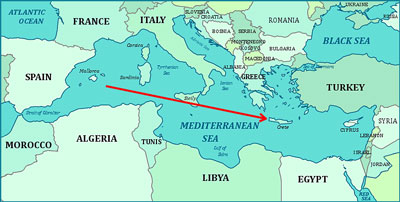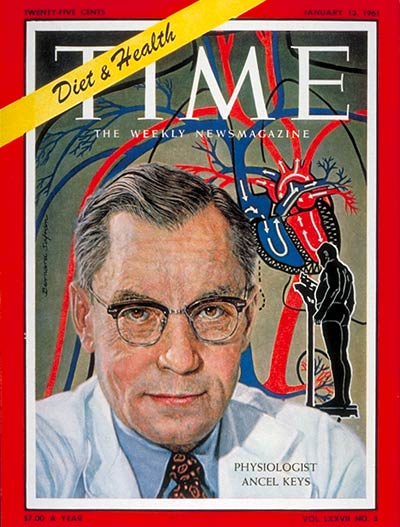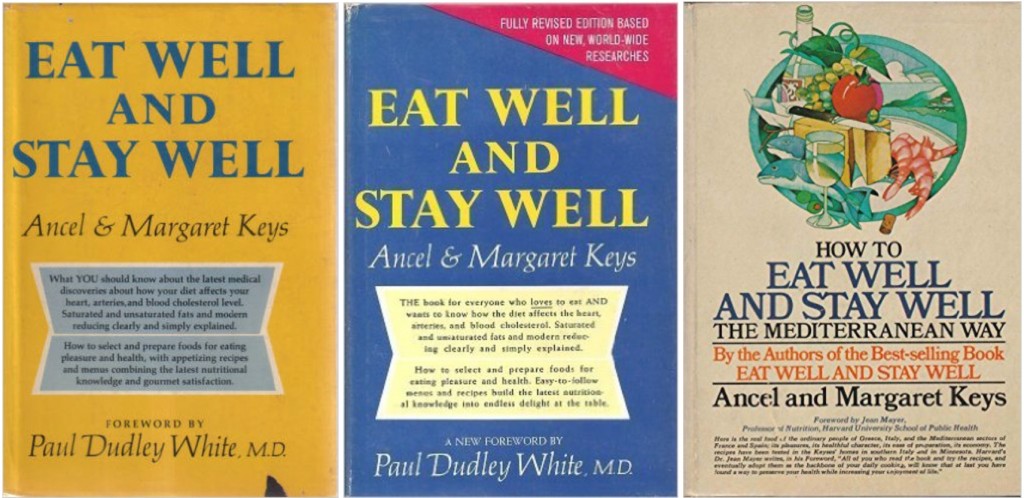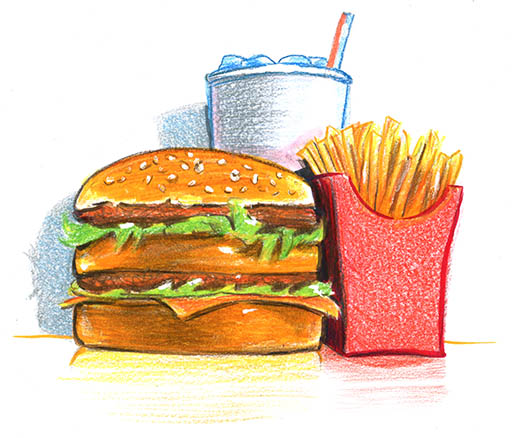Saturated with Lies: The Truth about Fat
Most
of what you’ve been told about fat has
nothing to do with your
well-being… and everything
to do with one man’s ego. It’s time to clear up the lies you’ve been
told and give you the facts. Your health depends on it.
Fat is a dangerous subject.
And writing this article about it is a bold thing to do.
BUT it’s time to bust the myths surrounding fat… and that’s exactly what I’m going to do right now.
You are likely ruining your own health at the moment because you don’t fully understand fat… like countless others have.
Many have even died from this misunderstanding, which began more than half a century ago… when fat started being blamed for heart disease.
The whole thing stemmed from bad nutritional information that ultimately made its way all around the globe… and it was all based on a questionnaire filled out by 31 men in rural Crete.1,2
That’s it. Thirty-one men were asked about what they remembered eating the day before.
I wish that were a joke, but I’m serious.
And, as you’ll learn in a minute, that 31-person, all-male dietary questionnaire is the foundation upon which we’ve largely built 50+ years of diet recommendations.
And what do we have to show for it?
Well, obesity, diabetes, and heart disease in the U.S. are now hitting all-time highs.3,4,5,6
In other words, despite being increasingly diet-conscious, we keep getting fatter and sicker.
And this, by the way, applies to our children, too.7,8
So, it seems pretty obvious we’re doing something horribly wrong…
And I’m going to show you exactly what that is, and why we believed the flawed science behind it — which demonized eating fat — for so long.
I’m also going to get down and dirty about different types of fat: which ones are good, and which ones are bad.
I’m even going to tell you about fats you’d never expect to be good for you, such as certain healthy saturated fats… and yes, even one type of healthy trans fat.
So, pay attention… because we’re about to clear a few extremely important things up.
Let’s start with that questionnaire.
ONE SCIENTIST’S PRIDE = DISASTROUS CONSEQUENCES

In the early 1950s, scientists were becoming increasingly alarmed by what seemed to be an epidemic of heart disease in the United States.9
People everywhere were dropping dead younger and younger of heart attacks, and nobody knew why.10
And this escalating panic reached a fever pitch on September 24, 1955, when U.S. President Dwight D. Eisenhower suffered a heart attack while in office.11
On the momentum of the resulting panic, it wasn’t hard for an ambitious physiologist named Ancel Keys to secure funding for his own international heart study in 1956.12
You see, based on some passing observations he made while living in Europe several years earlier, Keys had formed a hypothesis that eating saturated fat caused heart disease…13,14
…a hypothesis which was coldly dismissed when he presented it before the World Health Organization’s panel on atherosclerosis in 1955.15
After this blowoff, Keys — a famously headstrong man16,17 — was determined to prove himself right.18
So, he built up publicity for himself by confidently announcing in twenty different papers that dietary fat intake was connected to blood cholesterol levels and heart disease, despite questionable evidence…19
…and he had all of these papers published in leading scientific journals from 1957 to 1958.20
Riding the wave of this self-generated publicity combined with the heart attack scare, Keys commenced his international study — now known as the Seven Countries Study — in 1958.21,22
And from the moment this study began, dark things were on the horizon.
There were 3 HUGE Problems with Keys’ “Seven Country” Science…
We’ll start with the countries themselves…
1) Seven was not a lucky number.
Let’s pause on the name of that study for just a second:
“The Seven Countries Study.”
Nutrition data were available for 22 countries at that time…23,24 So, why would Keys only report on seven of them?
Well, many of Keys’ contemporaries believe he deliberately picked the countries that supported his theories about fat and left out the ones that didn’t. This is known in the scientific community as “cherry-picking.” 25,26,27
This might explain why he left out France, which had low rates of heart disease despite a high-saturated-fat diet — a phenomenon that later became known as the “French Paradox.” 28
2) Correlation is not causation.
And then, there is the matter of Keys’ data itself. You see, aside from cherry-picking his data, Keys did two other major things wrong…
First, he only pointed out correlations. Correlation means two things simply coincide. It doesn’t mean one caused the other.
For example, everyone who eats apples also eventually dies. There is a 100% correlation between eating apples and death. That doesn’t mean eating apples causes death.
Similarly, when Keys points out that people had long life and low rates of heart attacks in Crete and they also didn’t eat much saturated fat…29 that doesn’t mean they had low heart disease because they didn’t eat much saturated fat.
If he hadn’t cherry-picked his data, this might have been more obvious within the study.
There was another thing wrong with the data from Crete, though…
And that thing was data itself.

3) The case of the missing data.
You see, of the 300 men originally medically examined for the Crete section of the study, only 31 were actually surveyed about their diets.30
And the original surveys about what those men remembered eating over the previous seven days were unavailable for the study… So, Keys substituted in data from a previous questionnaire.31
There was also a lack of data on fruit and vegetable consumption for those 31 men. So, Keys used data on the availability of fruits and vegetables in Greece over the previous 4 years to guess what these men had eaten.32
So, in summary, Keys…
- took 31 men in rural crete and asked them a couple of times about what they ate…
- copied and pasted answers they had given early in the study to make it look like he had more data than he did…
- guessed what to put in place of whatever “data” was still missing…
And then he suggested that the resulting imaginary diet — later called the “Mediterranean Diet” 33,34 — was the reason for the long lives and low levels of heart disease observed in these men.35
Oh… and by the way… amidst the publicity of conducting this “groundbreaking study,” Keys landed on the cover of TIME Magazine in 1961.36,37

AND he got a book deal and hit the New York Times Bestsellers list:38,39,40,41

So, naturally, Keys was under a white-hot spotlight, and any conclusions he drew were going to be publicized everywhere.
And when he concluded that the low-saturated-fat “Mediterranean Diet” was ideal for heart health, people everywhere began adopting it.
But wait… It gets worse.
You see, even Keys was mindful enough to point the finger at a specific type of fat (saturated). However, when a few scientists came out later thinking that fat might be a cancer cause…42
…all fat started being slammed as unhealthy.
With the low-fat craze now at full force, people were left largely with carbs as their alternative major calorie source.
And by the way… the grain industry, in particular, didn’t mind any of this one bit.
You see, they’d already applied pressure to the USDA to make grains the largest recommended food group at the bottom of the Food Guide Pyramid, which the government was designing at the time to teach the public how to eat:43

And when the Food Guide Pyramid came out in 1992, right in the middle of the low-fat craze, everything lined up perfectly. People were left to wolf down the carbs for the next 20+ years.
And that brings us back up to the present: fatter and sicker than ever.
But what about the heart disease epidemic?
If fat wasn’t the cause, what was?
Well, here’s where it gets interesting…
Early in the 20th century leading up to the 1950s heart disease crisis, three key things happened:
- Crisco®,44 a cheap, hydrogenated cooking shortener, was released in 1911 – marking the beginning of industrial trans fat infiltrating our meals.45 And trans fats have been repeatedly linked to heart disease.46
- Arteriosclerotic heart disease was added to the International Classification of Diseases (ICD) in 1949, leading to a sudden increase in the number of deaths attributed to heart disease.47
- As the food industry grew, sugar intake rose steadily over the first half of the 20th century.48
The issue with sugar is particularly interesting…
 You
see, as far back as the 1950s, well-known scientists had
contradicted Keys’ fat-heart disease hypothesis… by pointing the
finger at sugar instead.
You
see, as far back as the 1950s, well-known scientists had
contradicted Keys’ fat-heart disease hypothesis… by pointing the
finger at sugar instead.
One particularly notable proponent of the sugar theory was respected British physiologist and researcher Dr. John Yudkin.49,50,51
As early as 1957, when Keys was still preparing for the Seven Countries Study, Yudkin published a study analyzing 41 countries (not 7!) and correlating heart disease to sugar, not fat.52
He published another study in 1964 furthering this theory,53 and in 1972, he released a book thoroughly exploring the dangers of sugar called Pure White and Deadly: The Problem of Sugar. In this book, Yudkin backed his sugar hypothesis up with a substantial amount of research.54
And Yudkin was not alone in his sugar suspicions. Nobel Prize®55 winner Dr. Linus Pauling publicly agreed with Yudkin about sugar shortly after Pure White and Deadly was released.56
And more recently, University of California San Francisco endocrinologist Dr. Robert Lustig gave a famous sugar lecture citing Yudkin that was posted online and went viral.57,58,59
Unfortunately, Keys and several other powerful figures who were invested in the low-fat trend retaliated against Yudkin in a shockingly brutal way…60
And that’s a story I’ll get to in the next Food Truth Letter post… coming out soon. Right now, we need to get back to the fat!
Sign up for the email list in the form at the upper right of this page or at the bottom after the citations, and I’ll shoot you an email when the next letter comes out.
Now you know the lies… so let’s get to the truth about fat.
To quote the esteemed Dr. Walter Willett, Chair of the Harvard School of Public health…
“Diets high in fat do not appear to to be the primary cause of
the high prevalence of excess body fat in our society, and reductions in
fat will not be a solution.”
– Dr. Walter Willett, December 2002
61
What that means is this: Fat in your food does not equal fat on your body.
Fat in your food equals fuel in your body.
So, here’s the real question: Which fats are good, and which fats are bad?
Glad you asked. Let’s start with the “infamous” saturated fat.
1) The Truth About SATURATED FAT
Now, there are some saturated fat sources you should honestly avoid for better health.
These mainly include fats from grain-fed, unhealthy, factory-farmed animals. Milk, meat, eggs, and fish are all problematic for your health when it comes to factory-farmed sources.62,63
This is due to the grain feed, harsh and dirty conditions, antibiotics and hormones, and diseases the animals are exposed to. These conditions also affect their omega-3 balance…64,65 which I’ll get to in a minute.
Now… if you get your saturated fats from good sources, such as grass-fed meat and dairy and cold-pressed coconut oil, they do some very important things in your body.

What Good Saturated Fats Do for You:
- Saturated fats such as conjugated linoleic acid (grass-fed butter), lauric acid (cold-pressed coconut oil), palmitic acid (palm oil, grass-fed meat, and grass-fed dairy), and myristic acid (grass-fed dairy and cold-pressed coconut oil) greatly support your immune function and cellular function, helping protect you from diseases (including cancer).66,67
- Saturated fats are crucial for your nervous system to function properly.68
- Palmitic acid, myristic acid, and lauric acid serve as premium fuel for your body to run the way it should.69
- From animal sources, saturated fats supply you with important fat-soluble vitamins like A, D, and K2.70
- When you’re getting enough omega-3 and not eating too much refined sugar and starches, saturated fats help reduce inflammation in the body.71
- Palmitic acid helps regulate your hormones.72 Saturated fats are also essential for your body to be able to produce hormones like testosterone and estrogen in the first place.73
- Saturated fats support pulmonary function, helping you to breathe better.74,75
- Saturated fats are crucial for your brain function, as your brain is largely made of saturated fats.76
The list goes on and on. In other words, saturated fats are crucial to your health, and cutting them out is a big mistake.
Again, though, the health benefits of saturated fat — or any other fat — are greatly affected by what you are consuming to get the fats… which is why I’m providing very specific examples.
Now, let’s move on to another type of fat: monounsaturated fat.
2) What You Should Know about MONOUNSATURATED FAT
This fat is found in avocados, nuts, seeds, olives, olive oil (use extra virgin, cold-pressed), and lard and tallow (grass-fed, pasture-raised).
It’s widely (and rightfully) accepted as extremely beneficial to the body,77 promoting weight loss, cardiovascular health, healthy cholesterol levels, lower diabetes risk, and lower breast cancer risk.78,79

There is, however, one monounsaturated fat source you should avoid: canola oil.
Despite historically being marketed as healthy, canola oil is riddled with chemical additives like bleach, deodorizers, and degummers. Not to mention, it’s processed at extreme temperatures that essentially ruin any nutritional value it might have had.80
So, skip the canola and spring for the coconut! (Or any of the natural sources I mentioned above.)
(Click here to share this with others on Facebook while you keep reading!)
Now, we’ve arrived at polyunsaturated fat.
3) What You Should Know about POLYUNSATURATED FAT
You may have heard of the two main polyunsaturated fats: omega-3 and omega-6.
They are both crucial in your diet because your body can’t function without them and yet it doesn’t produce either one of them on its own.81
Omega-3 fats are essential to nervous system function and endocrine function (particularly your body’s ability to regulate insulin). In fact, the very structure of the cells you’re made of depends on omega-3! 82
Omega-6 fats are crucial to cellular function, but without the proper balance of omega-3, they can start doing some terrible things inside you right away.83
Weight gain that you can’t stop, immune system malfunction, rampant inflammation, heart disease, and cancer are just a few of the things a poor omega-3 to omega-6 balance can easily churn up inside your body.84
The ideal omega-6 to omega-3 ratio is between 1:1 and 4:1.85,86

Good polyunsaturated fat sources that help you achieve a proper balance of omega-3 to omega-6 include wild-caught cold-water fish, pasture-raised meat and eggs, whole nuts and seeds, flax seed oil, and hemp seed oil.87,88
Fat sources with poor omega balances you should avoid are refined oils, such as soybean oil, cottonseed oil, vegetable oil, and corn oil.89
Also, polyunsaturated fats do NOT perform well as cooking oils.90,91 For cooking, use lard, tallow, avocado oil, olive oil, or coconut oil (olive oil and coconut oil at medium heat or lower).
Alright… we’ve now reached the big, bad wolf of fats. This one has been demonized, as it very well should. It’s one of the worst things you can consume.
I’m talking about trans fat.
4) The Truth about TRANS FAT
Keep in mind, there is one good trans fat, which I’ll get to in a moment. First, though, let’s deal with the bad stuff.
Trans fats are the hallmark of hydrogenated oils. Hydrogenation is the industrial process used to make vegetable oils more solid and stable for shipping, resulting in products like Crisco®92 and margarine.
Study after study after study has shown the extreme dangers of trans fats.
In addition to very easily making you fat, trans fat has been linked by a MOUNTAIN of evidence to not only obesity… but deaths from heart disease, colon cancer, breast cancer, and diabetes.93,94,95,96,97,98,99,100,101,102
So, you definitely want to keep this stuff out of your body.

Some common sources of trans fat include…
- margarine and artificial butter products
- solid cooking oils
- cooking spray
- highly processed foods (especially those stable at room temperature)
- fast foods
- processed snacks like chips and cookies
- artificial coffee creamers
- artificial frosting
And beware: Even though the government is cracking down on trans fat, manufacturers are definitely still finding loopholes to sneak it into your food without having to label it.103
Now, all that being said… there’s one trans fat that’s actually healthy, and it’s called conjugated linoleic acid (CLA).
CLA, because of its molecular makeup, is technically a trans fat… but it isn’t produced in a factory via hydrogenation. CLA occurs naturally in grass-fed butter and beef. (Notice a recurring food theme here?)
CLA has been shown to aid in weight loss, not to mention protect you against the development of cancer, heart disease, and diabetes.104,105,106
Alright…
Take a breath.
You now know the truth about fat.
Fat isn’t evil, and cutting it out of your diet is just about the worst thing you can do for weight loss or your health.
The real problem here is sugar, and it goes far beyond what you’ve likely ever imagined… and that’s exactly what I’m going to cover in the next letter.
Sign up for the mailing list in the form above, and I’ll shoot you an email when the letter is finished… along with tons of other great free information and stories for your health.
I also work with my team of scientists at regular intervals to develop helpful products according to your needs and feedback, and I’ll let you know about those, too. And you have direct input into what we develop!
AND ONE MORE THING:
I’m very serious about everything I do with Nucific, including articles like this.
After all, the Internet is clogged with unreliable and even dangerous health “information” that has no research to back it up.
And that’s why I’m so meticulous about giving you the straight goods on any topic I cover. It’s also why I cite sources so thoroughly.
So, if you feel that this information has helped you, be sure to SHARE this article with your friends and loved ones, so that they don’t stay misinformed!
There are social media buttons at the top and bottom of this page and links throughout the article to make sharing as easy as a single click.
It’s my mission to get real, reliable information out to you and to as many other people as possible. And I’ll always back this information up with ample sources.
That’s my pledge to you, and to everyone you care about.
Stay Healthy,
Dr. Amy Lee, MD
Nucific Board of Directors
http://nucific.com/blog/healthy-eating/saturated-with-lies-the-truth-about-fat-3/